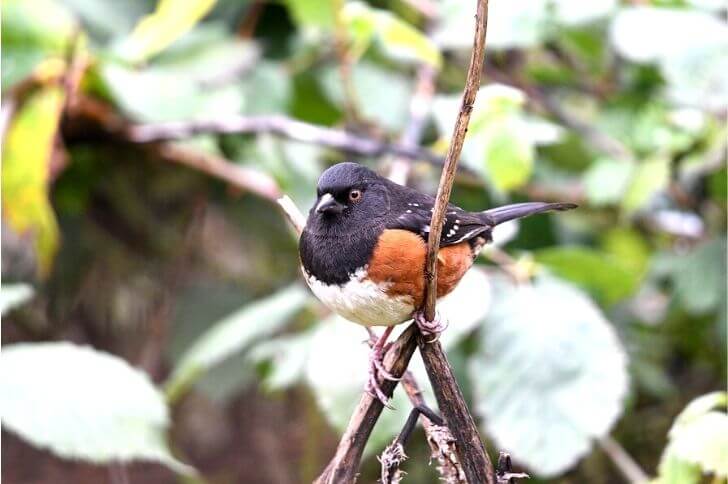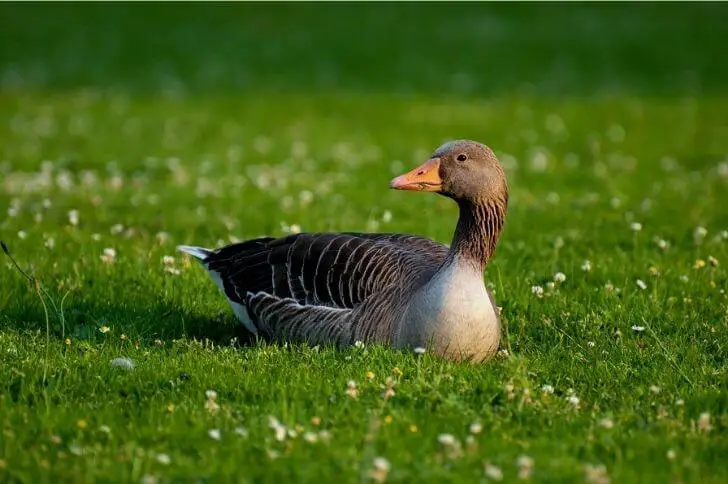Welcome to your guide to the wonderful world of yellow birds in San Diego! This article will provide a comprehensive look at the different species of yellow birds that can be found in this beautiful city.
We’ll guide you through the best locations to spot these vibrant birds, as well as offer some insight into their behavior and habits. Whether it’s for a casual stroll or serious bird watching, this article will help you experience San Diego’s incredible avian population from a new perspective.
List of Yellow Birds in San Diego California
1. Hooded Orioles
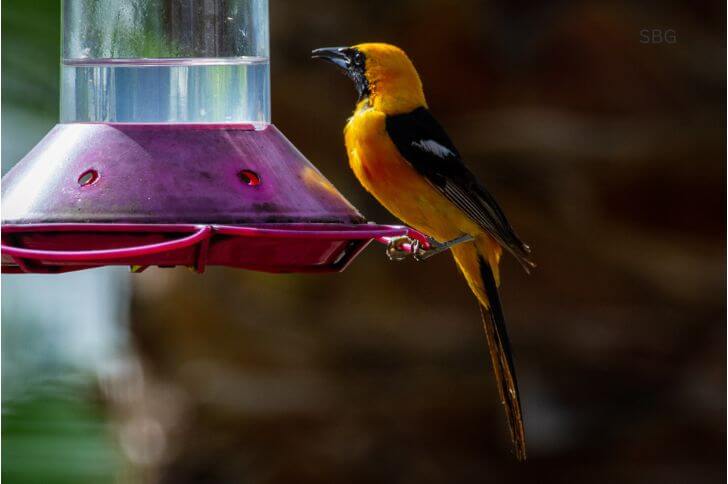
Identification:
Hooded orioles are resident breeders in San Diego and much of California. These vibrant songbirds have distinct features that make them easily identifiable. With their bright yellow hoods and chest and black wings and throats, the males of this species stand out from other birds within this range. Females are light brown on their back and a duller yellow on the underparts and head.
Habitat & Nesting:
In their natural habitats these birds can be found living amongst mesquite trees and other desert scrublands. They feed on spiders, beetles, caterpillars, and occasionally fruit. Hooded orioles are also known to frequently visit bird feeders where they will happily eat nectar mixes or jelly with gusto!
When can you see hooded oriole babies? Between April and August. During this time you’ll notice the female choosing a nesting site, then weaving a beautiful basket nest and later laying 3-7 eggs. These birds are great brooders and can raise 2 sets of 3-7 chicks each season.
2. Western Meadowlark
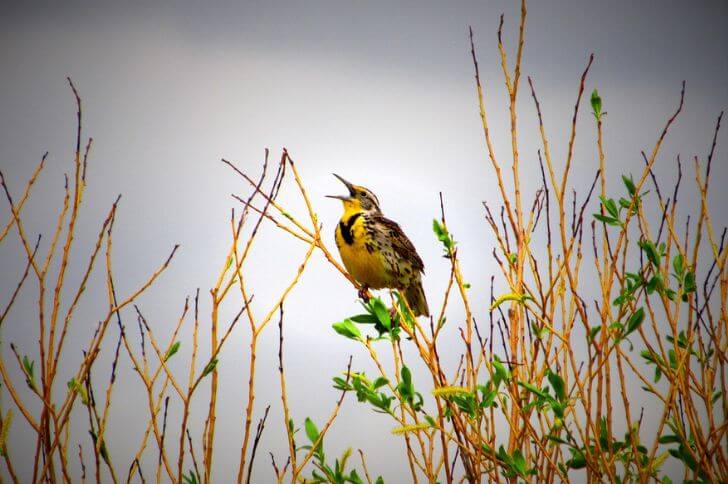
Identification:
Known for its flutelike melody, the western meadowlark is in the same family as blackbirds; icteridae. You can identify this San Diego bird by looking at its bright yellow chest and belly. Upperparts are brownish with dark bars and streaks. Note the prominent black V-shaped necklace. They are almost the same size as Baltimore orioles with a wingspan of 16.1 inches.
Habitat & Nesting:
Native to open grasslands, brush country, and agricultural areas, it’s found all year round in California. This yellow San Diego Bird has adapted well to human activity, making it one of the most commonly seen birds in many regions.
Mating typically occurs in late April through July. Male meadowlarks arrive at the nesting area a month earlier, scout for the perfect site, then spend the rest of the time defending this site. Also, males typically choose two females and each female meadowlark builds her nest. The nests are usually built near the ground, hidden in tall vegetation or inside a shrub. They’ll then raise one or two broods.
3. American Goldfinch

Identification:
American goldfinches are unmistakable. Sexes share similar plumage but males are more vibrant. This medium size bird is easy to identify due to its bright yellow body and black wings with white patches. Note the black forehead. Females are more lemon-yellow. Juvenile males are brown with a yellowish head. You can also identify them by their “po-ta-to-chip” calls.
Habitat & Nesting:
The male American goldfinch has a distinguishing lemon-yellow color on its back and head, while the female is duller in color. They are usually found in open areas such as fields, meadows, parks, gardens and suburban feeders. Due to their size and flight pattern they can be easily confused with other types of birds.
When can you see American Goldfinches in San Diego? You can spot them from September to May. From mid-May they move to their breeding areas.
4. Nashville Warbler

Identification:
What bird winters in San Diego? The Nashville warbler visits this area when it becomes cooler. A member of the wood-warbler family, this bright yellow and gray bird can be easily identified by its distinct coloring. They are small about the size of a chickadee.
Habitat & Nesting:
These yellow birds in San Diego prefer mixed tropical forests but also frequent gardens. They exclusively consume insects even in their wintering range. They prefer grasshoppers, caterpillars, flies and beetles.
In their breeding range, Northeastern United States, they can be found in mixed forests. They raise 4-5 babies per season.
5. Townsend’s Warbler

Identification:
The Townsends’s warbler is another new world warbler that winters in San Diego. Males are striking with gorgeous yellow-black striped bodies. They have a black throat and white markings on their wings. Females have duller streaks.
Habitat & Nesting:
Like the Nashville warbler, Townsend’s do not breed in San Diego. They migrate to the northern regions, nesting on the tallest trees. These yellow birds also prefer insects but will also eat peanuts and suet. You’ll spot them on feeders when temperatures are really low. These warblers can live up to 10 years.
Related Read: Common backyard birds in San Diego
6. Lesser Goldfinch

There are two subspecies of goldfinches; green-backed goldfinch and Arkansas black-backed goldfinch. The green-backed goldfinches are the most common in San Diego.
These are the smallest finches in North America; about 4.3 inches long and wingspan ranging from 5.9-7.9 inches. The males have a black cap, yellow underparts and dark wings with white markings. Females have an olive back with yellowing underparts.
Habitat & Nesting:
This cheery little bird can be found in open woodlands, meadows and grasslands across California. Its diet is made up of sunflower seeds and in their absence will consume elderberries. They breed in the north.
7. American Yellow Warbler
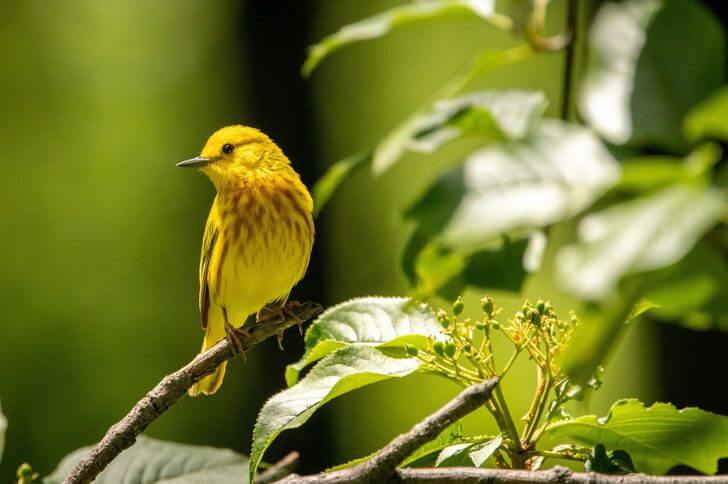
Identification:
With its vibrant yellow plumage and memorable “sweet” songs, the American yellow warbler is a beautiful yellow bird of San Diego.
Apart from the yellow hue, you can identify it by the brown streaks on the chest and beady eyes. Females do not have chest streaks and are duller.
Habitat & Nesting:
When can you spot yellow warblers in San Diego? From May to June. During their mating season, these small yellow birds in San Diego weave a nest in 4 days and raise one or two broods.
8. Western Kingbird

Identification:
Western kingbirds arrive in San Diego from early April. Their breeding season starts from mid-April.
This species has bright yellow underparts, and its upperparts are olive colored with brownish wings. Note the gray head and cute eyes.
Habitat & Nesting:
Western kingbirds feed mainly on insects, which they hunt while in flight. When they spot prey, they fly down to catch it with their beaks before quickly returning to another perch. While this species prefers open fields and grassy areas for hunting food, they often nest in trees or shrubs near human settlements such as farms or ranches.
Nesting happens on sycamores, mulberries, and cottonwood trees. Like other kingbirds, the female weaves a 6-inch nest. They can raise two clutches and the babies leave the nest after 19 days.
9. Western Tanager (Male)

Identification:
With their bright red heads, black wings and yellow bodies, western tanagers winter in San Diego. Males are yellow while females are olive in color. These yellow birds grow to about 7.5 inches and span 11.5 inches.
In addition to physical characteristics, song can also be used to identify a Western tanager. Its song consists of several clear whistles followed by rolling trills that can often be heard from far away distances.
Habitat & Nesting:
In the summer months, these birds travel to coniferous forests to breed. During courtship displays, males will sing more vigorously as they flutter their wings in order to attract potential mates.
They will build their nests in open areas. The female lays between two to five bluish green eggs. The male will stay nearby and protect his family from potential threats while also bringing food back for them to eat. Once the young are grown and independent, both parents will continue migrating south for winter before returning again when breeding season starts anew.
10. Wilson’s Warbler
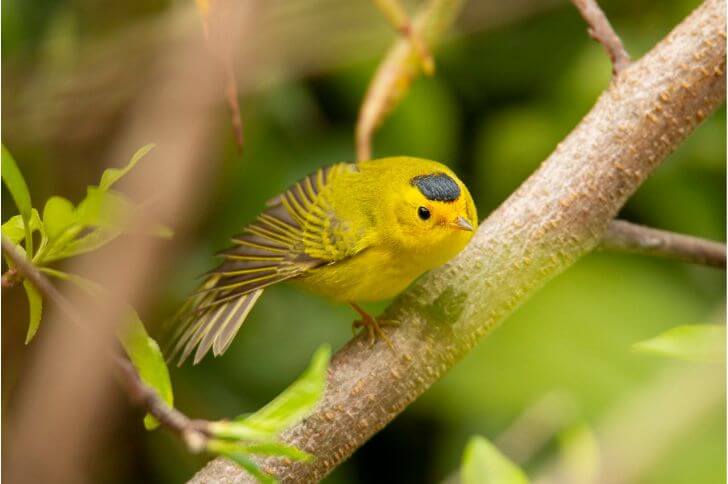
Cute and small, wilson’s warblers are another type of yellow birds in San Diego. Its distinctive olive and yellow appearance makes it easy to recognize in the wild. Males have a black cap while females do not .
This species is known for its trilling song that can often be heard during dawn and dusk hours. The male sings louder than the female to attract a mate, who will then help build their nest together in a low tree or shrub near the ground.
Habitat & Nesting:
It has an affinity for open woodlands, scrubby areas, and meadows with dense shrubs. Breeding season for Wilson’s Warblers usually begins in mid-April and lasts until late July. Like other California warblers, the female weaves a nest out of grass, moss and strip barks and then lines it with soft materials.
Once the nest is complete, she will lay anywhere from 4-5 eggs that hatch after about 10-13 days. Baby warblers are born with their eyes closed.
FAQs
What are the yellow birds in San Diego county?
All-year yellow birds in San Diego include western meadow larks, yellow-rumped warblers, Orange-crowned Warbler and the American goldfinch. Seasonal yellow birds include western tanagers, hooded orioles and western kingbirds.
Are there goldfinches in San Diego?
Yes, you can find American goldfinch birds in San Diego during their non-breeding months; September to May.
What is a yellow and black bird in San Diego
The yellow-headed blackbird can be found all year round in San Diego. Its body is black while its head is a brilliant yellow.
Where can I go bird watching in San Diego?
Common bird watching spots include:
- Marian Bear Memorial Park
- Point Loma
- Balboa Park
- Anza-Borrego Desert State Park
Sources:
https://www.audubon.org/field-guide/bird/hooded-oriole
https://en.wikipedia.org/wiki/American_goldfinch
Hi fellow bird watcher. Welcome to our small corner of the world. At the spanishbirdguides.com our mission is to share with other bird watchers the things we love about birds, where to go bird watching within the United States, and more. I’d also love to hear from you. Feel free to contact me about your bird watching escapades, share videos, photos and more.
